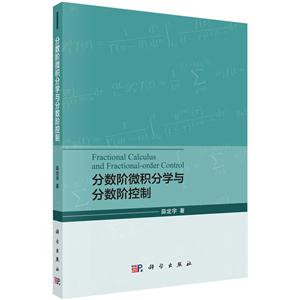
作者:慕嘉
页数:164
出版社:科学出版社
出版日期:2022
ISBN:9787030736628
电子书格式:pdf/epub/txt
内容简介
该专著主要包括了分数阶泛函微分方程、分数阶抽象常微分方程、分数阶抽象发展方程、基于临界点理论的分数阶边值问题、分数阶偏微分方程解对初值的连续依赖性、存在性、正则性、专享性、多解性等。该专著主要包括了分数阶泛函微分方程、分数阶抽象常微分方程、分数阶抽象发展方程、基于临界点理论的分数阶边值问题、分数阶偏微分方程解对初值的连续依赖性、存在性、正则性、专享性、多解性等。
目录
《博士后文库》序言
Preface
Chapter1 Preliminaries 1
1.1 Introduction 1
1.2 Fractionalintegrals and fractional derivatives 3
1.3 Mittag-Leffler functions 5
1.4 Measureof noncompactness 5
1.5 Semigroupsofoperators 6
1.6 Fixedpointtheorems 8
1.7 Definitions of solutions to abstract fractional equations 9
1.8 Other lemmas 11
Chapter2 Initial (or Boundary)Value Problems forFractional Diffusion Equations 13
2.1 Impulsive fractional diffusion equations with nonlocal initial conditions 13
2.1.1 Introduction 13
2.1.2 Existence of mild solutions 16
2.1.3 Examples 21
2.1.4 Notes and remarks 23
2.2 Initial problems for fractional diffusion equations in fractionalpower spaces 23
I2.2.1 ntroduction 23
2.2.2 Existence of q-mild solutions 25
2.2.3 Existence of q-classical solutions 30
2.2.4 Applications 30
2.2.5 Notes and remarks 32
2.3 Positive mild solutionstoperiodicboundaryvalue problemsfor fractional diffusion equations 32 Introduction 32
2.3.1 Contents
2.3.2 Existence of mild solutions 38
2.3.3 Examples 40
2.3.4 Notes and remarks 41
2.4 Periodicboundaryvalue problems for semilinear fractional differential equations 41
2.4.1 Introduction 41
2.4.2 Existence of mild solutions 44
2.4.3 Notes and remarks 51
Chapter3 Bounded Solutions toFractional Diffusion Equations 52
3.1 Bounded solutions to fractional diffusion equations with C0-semigroups 52
3.1.1 Introduction 52
3.1.2 Results for linear equations 59
3.1.3 Results for nonlinear equations 64
3.1.4 Examples 69
3.1.5 Notes and remarks 70
3.2 Periodic (orS-asymptotically) solutions to fractional diffusion equations in fractionalpower spaces 70
3.2.1 Introduction 70
3.2.2 Existenceofperiodic(or S-asymptotically) mild or classical solutions 74
3.2.3 Examples 81
3.2.4 Notes and remarks 82
3.3 Square-mean S-asymptoticallyperiodic solutions to fractional stochastic diffusion equations 82
3.3.1 Introduction 82
3.3.2 Existence-uniqueness of square-mean S-asymptotically !-periodic solutions 88
3.3.3 Asymptotically stabilityof square-mean S-asymptotically !-periodic solutions 98
3.3.4 Examples 99
3.3.5 Notes and remarks 100
Chapter4 Existence and Regularityof Solutions toFractional Diffusion Equations 101
4.1 Existence and regularityof solutions to fractional diffusion equations involving time-dependentdiffusion coefficients 101
4.1.1 Introduction 101
4.1.2 Existence and regularityof classical solutions 107
4.1.3 Notes and remarks 118
4.2 Existence and regularityof solutions to fractional diffusion equations involving time-space-dependent diffusion coefficients 118
4.2.1 Introduction 118
4.2.2 Existence and regularityof classical solutions 121
4.2.3 Notes and remarks 128
Bibliography 129
Index 144
编后记 145
节选
Chapter l Preliminaries 1.1 Introduction Fractional calculus is an important branch of mathematics, which is a generalizationof ordinary differentiation and integration to arbitrary real or complex order. Itis well known that the f’ractional order differential and integral operators are nonlocal operators. This is one reason why fractional differential operators provide anexcellent instrument for description of memory and hereditary properties of variousphysical processes. The subject is as old as differential calculus. In September 30th,1695, G. A. de L’Hospital wrote to G. W. Leibniz asking him about the differentiationof order最G. W. Leibniz response ” an apparent paradox from which, one day,useful consequences will be drawn “. After that, many mathematicians made manycontributions iii this field, such as N.H. Abel, A.K. Griinwald, J. Liouville, P.S.Laplace, J.B.J. Fourier, B. Riemann, M. Caputo, etc. However, due to the unclearapplication background, the development of fractional calculus is very slow in theearly stage. It was not uiitil 1970s that B. Mandelbort of Yale proposed fractaltheory and applied RiemannLiouville fractional calculus to study Brownian motionin fractal modia that fractional calculus dcvclopcd rapidly. We observe that fractional order can be complex in viewpoint of pure rnathernaticsand thcrc is much intcrost in dcvoloping the thooretical analysis and numcricalmethods to fractional equations, because they can describe the behavior of realdynamical systems in compact expressions, taking into account nonlocalcharacteristics like infinite memory [22, 23, 138] . Some instance are thermal diffusionphenomenon [39], botanical electrical impedances [71], model of love betweenhumans [4], the relaxation of water on a porous dyke whose damping ratio isindependent of the mass of moving water [134], and so forth. On the otherhand, dircction the bchavior of a proccss with fractional ordcr controllcrs wouldbe an advantage, because the responses are not restricted to a sum of exponentialfunctions, therefore a wide range of responses neglected by integer order calculuswould be approached [19]. For other advantages of fractional calculus, we can seereal materials [59,131,140,150,177] , control engineering [3,42] , electromagnetism [50],biosciences [110], fluid mechanics [80], electrochemistry [132], anomalous diffusionprocesses [53], dynamic of viscoelastic materials [83], viscoelastic systems [13],continuum and statistical mechanics [112] and propagation of spherical flames[114], robotic manupulators [139], gear transmissions [62], vibration systems [25],hydrogeology, boundary layer effect of pipeline, signal processing and systemidontification, quantum cconomy, fractal thcory, hcat transfcr, clcctrical circuits,polymer physics, finance, hydrology and even biology [140], etc. The types of fractional differential equations mainly include neutral differentialequations, f’unctional differential equations, impulsive differential equations,diffcrontial cquations in Banach spacc, partial diffbrontial equation (such as Laplacoequation, diffusion equation, wave equation, Schrodinger equation, NavierStokesequation, Heisenberg equation, Langevin equation, FokkerPlanck equation, etc),uncertain differential equation (such as stochastic differential equation, fuzzydifferential equation, etc.), chaotic system, Hamiltonian system, Lorenz system,financial system, neural network, etc. There are several papers regarding abstractforms of fractional partial equations [85, 89]. For more details, we can ref’er to[119, 182184, 188, 189, 193]. This aspcct clcarly indicatcs the importancc andadaptation of fractionalorder operators in the mathematical modeling of scientificand technical problems. For instance, in the study of fractional advectiondispersionequation and fractional FokkerPlanck equation [17, 18], a laboratory tracer test hasindicated that fractional differential equations approximate Levy motion better thanintegerorder equations. For more details, see [14, 24, 29, 34, 40, 100, 110, 178]. More and more experimental data show that the traditional integerorderdiffusion equations are not enough to describe some anomalous diffusion phenomena.In real life, the regular diffusion phenomenon (integer order case) only occurs in afew special cases. It has been observed that the mean square displacement of adiffusive material is proportional to t when tj in normal diffusion (integerorderdiffusion), but this proportionality becomos of tho ordcr to for tj oo in casc ofanomalous diffusion. Compared with the traditional diffusion equations (first order),with fractional diffusion equations, subdifFusion or supdiffusion phenomenon canbe described when its order is between o and I or between I and 2, respectively.For example, if the first derivative is replaced by the fractional order aE (0,1),the diffusion speed will be slowed down due to the memory characteristics of thefractional derivative, whic















